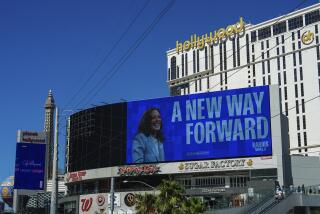Retooling a Gambling Town Image
- Share via
RENO — The way Larry Dinelli was gazing so lovingly upon the 1929 Ford sports coupe, you’d swear he was enraptured by the vision of a high school sweetheart who hadn’t aged a day.
“That’s the kind of car I drove, back in 1955, as a 15-year-old,” said Dinelli, a retired pressman from Santa Rosa, Calif. “Bought it for $5 and a bottle of wine. Seeing this car re-energizes me. Those were good times.”
Dinelli is one of about 200,000 people swarming around town this weekend for Reno’s annual time warp.
Called Hot August Nights, it celebrates the automobile as a touchstone to America’s carefree youth--and reflects the myriad ways Reno is promoting itself as something other than just a gambling town.
The streets of Reno and neighboring Sparks and Lake Tahoe are flooded with the T-buckets of the ‘20s, the roadsters and their rumble seats of the ‘30s, the sloped coupes of the ‘40s, the chromed sedans of the ‘50s and the roaring muscle cars of the ‘60s.
While there are a few larger classic car shows along the East Coast, collectors say this event, which concludes tonight, is the greatest of them all because it takes over the entire town.
Indeed, Hot August Nights, which pumped $74 million into the local economy last year, is the largest event staged in Reno, which may just be the capital of annual festivals.
With the steady spread of gambling throughout the country--95% of Americans live within a two-hour drive of a casino, notes Reno Mayor Jeff Griffin--this biggest little city in the world is learning to market itself as a multipurpose recreation destination.
To bolster tourism, the region’s various visitor marketing agencies agreed two months ago to work collectively to promote Reno, Sparks and Lake Tahoe as a single destination. For years, they had pitched their own events in competition with one another.
“We’re coming to realize that there’s a host of reasons why people come here,” Griffin said. “We use to be quite provincial. We wouldn’t say ‘Tahoe’ and ‘Reno’ in the same breath.”
Last year, 5.2 million people visited the area, thanks in part to a $4-million marketing campaign by the Reno-Sparks Convention and Visitors Authority.
By comparison, the Las Vegas tourism board Convention and Visitors Authority is spending about $82 million this year to promote the gambling mecca, which draws about 35 million visitors annually.
Much of the burden in promoting Reno is taken by the individual special events that, collectively, clog the civic calendar all year long.
Last week, Reno concluded its monthlong Artown festivities in Wingfield Park, an island in the Truckee River.
The Best in the West Nugget Rib Cook-Off begins Aug. 30, followed in September by the Great Reno Balloon Race, the National Championship Air Races and the sound of roaring motorcycle pipes at Street Vibrations.
There are jazz festivals, Basque festivals, book festivals, music festivals and ballet festivals.
Not all of Reno’s efforts to attract visitors have paid off. In 1995, the Reno-Sparks Convention and Visitors Authority built the National Bowling Stadium, a posh $50-million facility to host professional bowling tournaments.
It is used, however, only 12 months out of 36 and stands mostly dark the rest of the time. Even after adding a 1% room tax to help pay for its operations, its expenses still outstrip its revenue by more than $1 million a year.
But downtown, where Virginia Street hosts glitzy casinos, pawnshops and hole-in-the-wall liquor stores, shows signs of rebound.
Civic boosters point to last month’s opening of Siena, an elegant, $70-million riverfront hotel and casino--the first to open in Reno in six years. Nearby, boutiques and artisan lofts are springing up along the banks of the Truckee River as it courses through downtown.
The promising development follows last year’s demolition of the Mapes, a 53-year-old structure that was the nation’s first combination hotel-casino-entertainment venue.
Its implosion marked the first time a building listed on the “most endangered” list by the National Trust for Historic Preservation met its doom. No investors would come to its rescue.
The city is not sure what to do permanently with the site on the Truckee River but for now, will erect a skating rink there.
For now, nothing matches the success of Hot August Nights--or the story behind Philip Muller’s beauty.
The Palm Desert man, who organizes the weekly Palm Springs Cruise Nights, said his grandmother bought, in 1954, a new Chevrolet Bel-Air convertible.
But after a crash three months later, she refused to drive it.
For more than 30 years, it sat in her Palm Springs yard, a tree growing through its floorboard, enveloping the car like a four-wheeled planter.
After his grandmother’s death, Muller cut down the tree and salvaged the car, and this week he was busy polishing the chrome and dusting its butterscotch paint as passersby stopped to admire.
“This just isn’t a car show,” he said. “This is a car event.”
More to Read
Inside the business of entertainment
The Wide Shot brings you news, analysis and insights on everything from streaming wars to production — and what it all means for the future.
You may occasionally receive promotional content from the Los Angeles Times.










